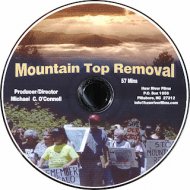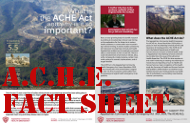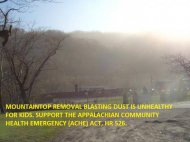
Federal Scientists Link Communities Hazardous Dust to Mountaintop Removal
Oct 7, 2014

Atmospheric Particulate Matter in Proximity to Mountaintop Coal Mines:
Environmental and Human Health Impacts
For Immediate Release Oct. 6, 2014
Federal scientists link communities’ hazardous dust to mountaintop removal
Contacts:
Bo Webb, ACHE coordinator, 304-237-0065, webb.bo@gmail.com
Maria Gunnoe, ACHE campaign, 304-245-8481, wvhollowgirl@gmail.com
Bob Kincaid, ACHE campaign, 304-640-6495, bobkincaid@gmail.com
WASHINGTON, D.C.— For the first time, federal scientists have confirmed elevated levels of mountaintop removal airborne dust in neighboring communities. The US Geological Survey found the fine dust, a type known to harm human health, at levels nearly six times that of communities without mountaintop removal coal mining nearby. The report shows that the dust comes from the mountaintop removal sites and not from other sources. These areas have higher rates of several serious illnesses, including those associated with this type of dust exposure. This study, entitled “Atmospheric Particulate Matter in Proximity to Mountaintop Coal Mines: Environmental and Human Health Impacts,” has been submitted to submitted to Environmental Geochemistry and Health for publication.
Contacts:
Bo Webb, ACHE coordinator, 304-237-0065, webb.bo@gmail.com
Maria Gunnoe, ACHE campaign, 304-245-8481, wvhollowgirl@gmail.com
Bob Kincaid, ACHE campaign, 304-640-6495, bobkincaid@gmail.com
WASHINGTON, D.C.— For the first time, federal scientists have confirmed elevated levels of mountaintop removal airborne dust in neighboring communities. The US Geological Survey found the fine dust, a type known to harm human health, at levels nearly six times that of communities without mountaintop removal coal mining nearby. The report shows that the dust comes from the mountaintop removal sites and not from other sources. These areas have higher rates of several serious illnesses, including those associated with this type of dust exposure. This study, entitled “Atmospheric Particulate Matter in Proximity to Mountaintop Coal Mines: Environmental and Human Health Impacts,” has been submitted to submitted to Environmental Geochemistry and Health for publication.
“This new report sounds frightening alarms about the air that we breathe every day, air made dangerous by mountaintop removal blasting," said Maria Gunnoe of Boone County, W.Va. "We demand to know why important information about health hazards is being withheld." Other USGS health research relating to mountaintop removal have been delayed and not yet released. In 2013, USGS funding for mountaintop removal health studies was eliminated, and the current study held up for over a year. The Appalachian Community Health Emergency (ACHE) campaign has submitted a Freedom of Information Act request in an effort to determine why funding was cut.
“Politicians such as W.Va. Sen. Joe Manchin should place the health of their constituents first,” said Bo Webb, ACHE campaign coordinator. “Instead, they ignore, deny, or suppress critical information about epidemic proportions of cancer, heart disease and birth defects, or they waste taxpayer dollars filing frivolous lawsuits that would expedite mountaintop removal. This USGS report confirms the urgency of the ACHE Act, HR 526. It is time for the US Congress to pass the ACHE Act as a matter of national health priority.” The ACHE Act would halt new or enlarged mountaintop removal permits unless and until the federal government completes a definitive health study determining that the process does not harm residents’ health.
The scientists compared airborne dust samples collected from communities near mountaintop removal sites to samples from communities without the practice. They found levels of the dust, including aluminosilicate particulate matter (PM), nearly six times higher in mountaintop removal communities than in the control areas. The report also states, “The human respiratory system is directly affected by aluminosilicate dust exposure, and the link between PM exposure and both respiratory and cardiovascular diseases is well established.”
Mountaintop removal involves the clear-cutting of mountain forests and then blasting the layers of rock over the coal. Coal companies detonate over five million pounds of explosives, the equivalent of over 4,000 Tomahawk cruise missiles, per day in the region. Used in West Virginia, eastern Kentucky, eastern Tennessee, and southwestern Virginia, the process has eliminated over a million acres of the Appalachian Mountains. Cancer, lung disease, heart disease, birth defects, and other illnesses are alarmingly higher in communities near mountaintop removal sites.
The ACHE campaign’s Cary B. Reed said, “When growing up, I thought that all Appalachian children could run through the woods wild and free like I did. Now several communities feel like a war zone with daily blasting. All children should grow up playing outside and not worry about breathing the air. Everyone should call their US congresspeople to support the ACHE Act as a critical health issue.”
“Politicians such as W.Va. Sen. Joe Manchin should place the health of their constituents first,” said Bo Webb, ACHE campaign coordinator. “Instead, they ignore, deny, or suppress critical information about epidemic proportions of cancer, heart disease and birth defects, or they waste taxpayer dollars filing frivolous lawsuits that would expedite mountaintop removal. This USGS report confirms the urgency of the ACHE Act, HR 526. It is time for the US Congress to pass the ACHE Act as a matter of national health priority.” The ACHE Act would halt new or enlarged mountaintop removal permits unless and until the federal government completes a definitive health study determining that the process does not harm residents’ health.
The scientists compared airborne dust samples collected from communities near mountaintop removal sites to samples from communities without the practice. They found levels of the dust, including aluminosilicate particulate matter (PM), nearly six times higher in mountaintop removal communities than in the control areas. The report also states, “The human respiratory system is directly affected by aluminosilicate dust exposure, and the link between PM exposure and both respiratory and cardiovascular diseases is well established.”
Mountaintop removal involves the clear-cutting of mountain forests and then blasting the layers of rock over the coal. Coal companies detonate over five million pounds of explosives, the equivalent of over 4,000 Tomahawk cruise missiles, per day in the region. Used in West Virginia, eastern Kentucky, eastern Tennessee, and southwestern Virginia, the process has eliminated over a million acres of the Appalachian Mountains. Cancer, lung disease, heart disease, birth defects, and other illnesses are alarmingly higher in communities near mountaintop removal sites.
The ACHE campaign’s Cary B. Reed said, “When growing up, I thought that all Appalachian children could run through the woods wild and free like I did. Now several communities feel like a war zone with daily blasting. All children should grow up playing outside and not worry about breathing the air. Everyone should call their US congresspeople to support the ACHE Act as a critical health issue.”
XXXXXXXXXXXXXXXXXXXXXXXXXXXXXXXXXXXXXXXXXXXXXXXXXXXXXXXXXXXXXXXXXXXXX
Laura Kurth, Allan Kolker , Mark Engle, Nicholas Geboy, Michael Hendryx, William Orem, Michael McCawley, Lynn Crosby, Calin Tatu, Matthew Varonka , and Christina DeVera
L. Kurth, M. Hendryx1 School of Public Health, West Virginia University, P.O. Box 9190 Morgantown, West Virginia, USA,
e-mail: lesch@mix.wvu.edu
Phone: 304-285-6383
Fax:304-293-3755
1Present address: Department of Applied Health Science, Indiana University, Bloomington, Indiana, USA
A. Kolker, M. Engle2
Eastern Energy Resources Science Center, U.S. Geological Survey, 956 National Center, Reston, Virginia, USA
2Concurrent address: Department of Geological Sciences, The University of Texas at El Paso, El Paso, Texas, USA
3Concurrent address: University of Medicine and Pharmacy, Timisoara, Romania
Abstract
Mountaintop removal mining (MTM) is a widely used approach to surface coal mining in the U.S. Appalachian region whereby large volumes of coal overburden are excavated using explosives, removed, and transferred to nearby drainages below MTM operations. To investigate the air quality impact of MTM, the geochemical characteristics of atmospheric particulate matter (PM) from five surface mining sites in south central West Virginia, USA and five in-state study control sites having only underground coal mining or no coal mining whatsoever were determined and compared. Epidemiologic studies show increased rates of cancer, respiratory disease, cardiovascular disease, and overall mortality in Appalachian surface mining areas compared to Appalachian non-mining areas. In the present study, 24-hour coarse (> 2.5 μm) and fine (≤ 2.5 μm) PM samples collected from two surface mining sites in June 2011 showed pronounced enrichment in elements having a crustal affinity (Ga, Al, Ge, Rb, La, Ce) contributed by local sources, relative to controls; follow-up-sampling in August 2011 lacked this enrichment, suggesting PM input from local sources is intermittent. Using passive samplers, dry deposition total PM elemental fluxes calculated for three surface mining sites over multi-day intervals between May and August 2012 were 5.8 ± 1.5 times higher for crustal elements than at controls. Scanning microscopy of 2,249 particles showed that primary aluminosilicate PM was prevalent at surface mining sites compared to secondary PM at controls. Additional testing is needed to establish any link between input of lithogenic PM and disease rates in the study area.
Conclusion
Using multiple sampling approaches, limited comparisons in this study show greater proportions of primary lithogenic aluminosilicate PM, or geochemical constituents associated with primary PM, in study sites with ongoing surface mining relative to internal controls with underground mining or external controls with no mining. Input of locally-derived PM is likely to be intermittent according to mine production schedules and other factors, but differences in PM fractions between surface mining sites and controls are evident on time scales of as much as one year. Surface mining methods are generally more economical and considered to be safer for workers than underground mining, but environmental impacts to nearby areas and health impacts to nearby residents must be considered. Recent epidemiological studies indicate residents of the surface mining area in this study have elevated chronic cardiovascular disease mortality, cancer mortality, total mortality, and respiratory symptoms compared to people living in the control area (Ahern and Hendryx 2012; Esch and Hendryx 2011; Hendryx et al. 2012; Hendryx 2011;
Hendryx and Ahern, 2008; Hendryx and Luo 2014). The human respiratory system is directly affected by aluminosilicate dust exposure, and the link between PM exposure and both respiratory and cardiovascular diseases is well established (Brook et al. 2010; Dockery 2001; Dominici et al. 2006; Pope and Dockery 2006; Schwartz 1994). The present study indicates that PM exposure is greater at surface mining sites, but additional testing with larger sample populations is required to establish any link between the input of lithogenic PM generated by surface mining and health outcomes of area residents.
Acknowledgements
We acknowledge the support of the USGS Energy Program for participation in the study by USGS authors. For use of SEM-EDX facilities, we acknowledge the WVU Shared Research Facilities.
We thank Ruth Wolf, analyst, for trace element data obtained at the USGS Central Mineral and Environmental Resources Science Center Laboratories, Denver, CO. Initial reviews by Madalyn Blondes and James L. Coleman, USGS, helped improve the manuscript as did subsequent reviews by Journal reviewers.













